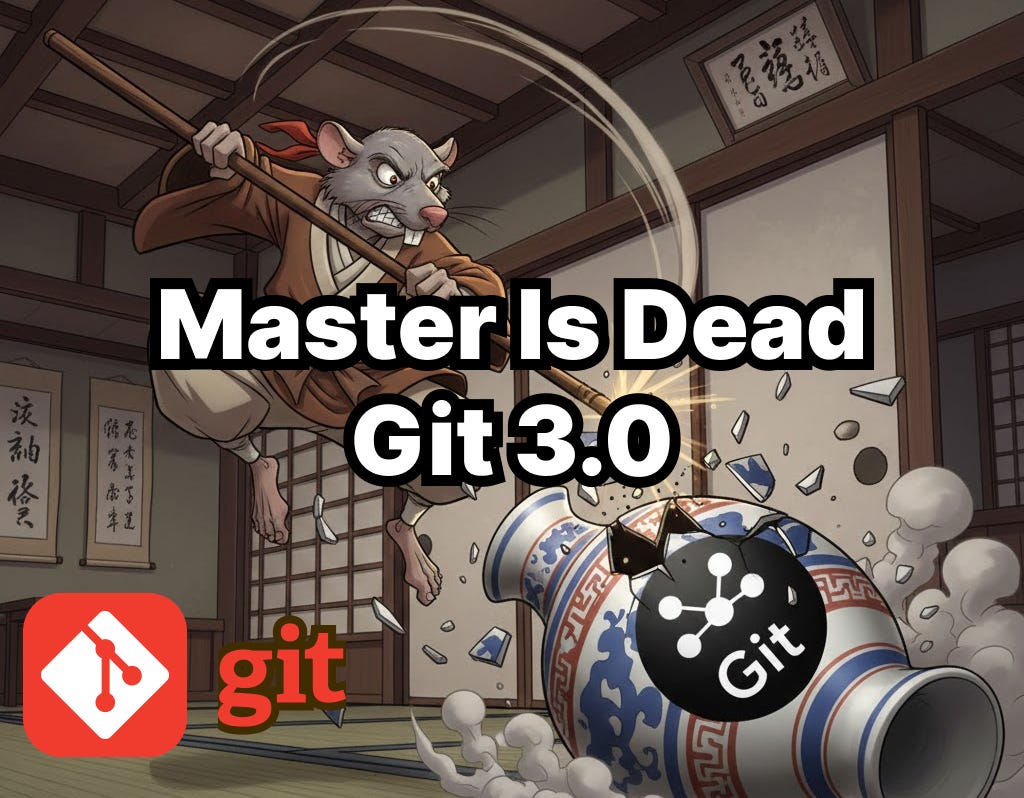Git 3.0 Finally Retires Master: What Developers Need to Know
Git 3.0 Kills “Master”: A New Era for Default Branches
For more than a decade, every git init quietly created a master branch. Even after GitHub, GitLab, and nearly every major platform migrated to main, the Git CLI itself remained frozen in the past. But that era is finally ending.
Starting with Git 3.0, the default branch for new repositories will no longer be master, but main — aligning Git with the modern tooling ecosystem and long-standing community requests.
This isn’t just a symbolic rename. Git 3.0 arrives with several deep technical changes that will reshape workflows, security, and long-term compatibility across the entire developer ecosystem.
Welcome to the post-master world.
Why Git Is Finally Switching to “main”
The request isn’t new.
Back in 2020, the Software Freedom Conservancy asked major projects to replace the term master with something neutral and inclusive. Within months:
GitHub switched its default branch to main
GitLab offered automatic migration
CI systems, CD pipelines, and dev tooling followed suit
And yet… Git itself didn’t change.
Users had to manually configure:
git config --global init.defaultBranch mainGit maintained the status quo to avoid breaking scripts, tutorials, legacy pipelines, and enterprise workflows that assumed master.
But as of Git 2.52, the team officially confirmed the upcoming switch. Git 3.0 completes that shift — finally aligning the CLI with modern platforms.
For most developers, nothing will change. For companies with giant monorepos, old CI systems, and dusty Bash scripts still referencing master… this may introduce breaking surprises.
What Else Is Coming in Git 3.0
Yes — the main migration is the headline. But the real story?
Git 3.0 contains several major under-the-hood upgrades developers should prepare for.
Let’s break them down.
1. SHA-256 Becomes Git’s Default Hash
For 19 years, Git has relied on SHA-1, a hash once considered secure — until attacks proved otherwise.
Git already introduced optional SHA-256 support in past releases, but Git 3.0 makes it the default.
Why This Matters
Stronger cryptographic guarantees
Modern security standards
Future-proofing against collisions
Example: Checking hash algorithm
git hash-object --hash=sha256 README.mdOlder SHA-1 hashes still work. Git includes a compatibility layer for mixed repos, but long-term:
New repos = SHA-256
Old repos = supported but encouraged to migrate
Expect enterprise-level migration tools to appear closer to Git 3.0’s release window.
2. A New Object Storage Format
Git’s traditional .git/objects structure predates Docker, SSDs, and even modern Linux kernels.
Git 3.0 introduces a faster, optimized storage backend designed to reduce overhead, especially on Windows and macOS where Git filesystem I/O is notoriously slow.
Potential Improvements
Faster cloning
Faster
git checkoutReduced disk usage
Better performance for huge monorepos
Example of inspecting storage backend:
git count-objects -vHIf you’ve ever worked in a repo with 5+ GB of history, this is very good news.
3. Rust Is Becoming Part of Git’s Core
Rust in Git? Yes. And not just experiments.
Git has been incrementally rewriting performance-critical components in Rust, similar to how Linux kernel and Python ecosystems are slowly adopting it.
Git 3.0 is the first release where Rust integration becomes:
formal
officially supported
part of the build system
Why Rust?
memory-safe
fast
perfect for complex low-level tooling
easier contribution path for modern developers
Expect future Git releases to include more Rust rewrites, reducing segmentation faults, memory errors, and undefined behavior that C-based Git sometimes suffers from.
What Developers Should Do Before Git 3.0 Lands
Git 3.0 isn’t here yet (expected around late 2026), but you should prepare your workflow.
1. Check scripts that reference “master”
Look for anything like:
git checkout master
git push origin master
git merge masterLegacy CI/CD pipelines may break.
Rewrite them now:
git checkout main
git push origin main
git merge main2. Update deployment pipelines
Examples of pipelines that may break:
GitHub Actions
GitLab CI
Jenkins
Bitbucket Pipelines
Bash deploy scripts
Example for GitHub Actions:
on:
push:
branches:
- mainIf your workflows still use master, migrate ASAP.
3. Audit internal repositories
Teams often have:
onboarding docs
templates
boilerplates
shared Bash scripts
automation tools
All of them should be updated to the new default branch terminology.
Examples for Updating Existing Repos
Rename master → main
git branch -m master main
git push -u origin main
git push origin --delete masterOr on GitHub:
gh repo edit --default-branch mainWill Existing Repositories Break?
No — Git is extremely conservative.
Repos with
masterwill continue to work.Branch names will not be auto-migrated.
Git 3.0 only changes the default branch name for new repos.
Still, older systems expecting master may require manual fixes.
Why This Change Matters (Even If You Already Use main)
Git’s default branch name is referenced literally everywhere:
programming tutorials
textbooks
CI examples
open-source templates
blog posts
YouTube tutorials
onboarding guides
Git 3.0’s switch makes the ecosystem consistent for the first time since 2020.
It’s less about politics and more about reducing confusion for new developers.
Git 3.0: A Symbolic Change With Real Technical Upgrades
To summarize:
✔ Git 3.0 default branch = main
✔ SHA-256 = default hash
✔ New optimized object storage
✔ Rust integration goes official
✔ Ecosystem modernized for future decades
It’s the biggest Git update since 2.0 in 2014 — not because of the branch rename, but because Git is evolving into a faster, safer, more modern tool.
By the time Git 3.0 drops, most developers won’t notice the transition.
But the few who do — especially those running large enterprise systems — should start preparing now.



